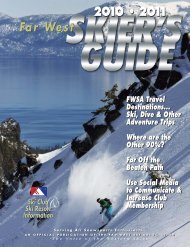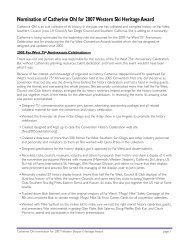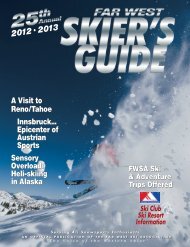Download pdf - Far West Ski Association
Download pdf - Far West Ski Association
Download pdf - Far West Ski Association
You also want an ePaper? Increase the reach of your titles
YUMPU automatically turns print PDFs into web optimized ePapers that Google loves.
▲Since the first World <strong>Ski</strong>ing Championships in Valdez, Alaska in 1991, andnumerous Warren Miller movies, steep and deep terrain has been a draw to thousandsof hard core skiers. Since then, most ski resorts master plans are includinglift served double black diamond shoots, off piste trails and backcountry terrain foradvanced skiers and boarders. When the adventure skier/boarder desires deeperpowder and more thrills to make first tracks in fresh powder, they may elect tohave the ultimate adrenalin exhilaration. Heli-skiing is not only for the young, butalso for the young-at-heart.As a member of the Balboa <strong>Ski</strong> and Sports Club, my first heli trip waswith FWSA in 2000 which was organized by Ron Anderson. We went withCMH in Canada and skied The Cariboos. Several years later, I met KevinQuinn who runs Points North Heli Adventures (PNH) at a ski show in DelMar, California. I was a vender at the show selling Snowshark Monoskis.A few weeks passed when I met Kevin again at <strong>Ski</strong> Dazzle in Los Angeles.I asked him more about PNH. I’ve been skiing there every year since.My booth was in the same row as Kevin’s and Warren Miller. I mentionedto Warren that I was interested in heli skiing with Kevin at PNH. Hereplied, “You could not find nicer people to ski with than Kevin and Jessica”. Afterall, Warren should know since PNH had been in many of Warren’s movies.Jessica Sobolowski, an extreme heli skier, is Kevin’s wife. Heli runs are usuallynamed by the person who made the first descent. The biggest one iscalled Pontoon which has been featured in many Warren Miller movies.Most runs are on the interactive zone map.The number one item PNH is concerned about is SAFETY. Nothingsurpasses this. The PNH pilots are amazing. They have been flying overthe Chugach for many years and know how to land a heli in small places.However, there have been times when a landing is not possible due to awind change or other conditions. The landing will then be aborted and anotherlocation will be found. Pilots always have the last word on safety.PNH has over 1,000 square miles of amazing terrain and 99% of it isabove treeline. People often ask me about the terrain. I have been goingthere for four weeks a year for the last nine years and I am still amazed atthe beauty and grandeur of the mountains and glaciers. Having your lunchon a glacier or on top of a mountain while looking at a huge glacier is somethingmost people will never experience. The terrain is expansive! Thebeauty is exquisite! This past year, I skied over thirty new runs.Warren Miller talked about the snowflakes in Alaska in one of hismovies. He stated, that the cold air from the north and the warm air fromthe gulf creates a snowflake with more cohesiveness. This allows one toski steeper terrain than you can in soft dry powder. However, even thoughyou know you can still safely ski 10 degrees steeper, in your mind, it is still10 degrees steeper.On a typical heli week, one arrives on a Saturday. Most heli operationsare only running for a short eight week season, automatically limiting availabilityeach year. Spots fill up quickly and are usually booked well in advance.During each spring week, only 30 or so skiers can be accommodated.They fly into the Cordova Airport (CDV) where three vans and guides greetguests and load the gear.Once you arrive at the Orca Adventure Lodge, you will be greeted bythe rest of the staff to enjoy some cheese and salami while you fill out yourpaper work, get weighed, photographed and assigned to a group. Sundaymorning is your group beacon and heli training. You will learn how to enterThis group is heading down Filmland where manyWarren Miller movies have been made. Just look at theangle of that slope! Before each run, the guide explains thebest way to negotiate it, points out obstacles and givesencouragement to get down safely. No matter how long onecries at the top, the helicopter does not come to pick you up!the helicopter, and obtain the order for the day.Your first day out is intense. I would call it “sensory overload” for afirst time heli skier. Your guide will come to you at breakfast and tell youwhen you need to be in the staging room with your gear on. No matterhow many heli days you ski, there is something exciting and magical tostand there and watch two or three helicopters take off in a row about 30yards from you, knowing in twenty minutes it will be your turn. That isexactly why Kevin calls it, “The Magic Carpet Ride”.When skiers get out of the heli for the first time, you can see the excitementon their faces. As many days as I’ve heli skied, I am still amazedat the awesome scenery and beauty of the terrain. After the first few runs,the guides are aware of your ability and to what terrain they can safely takeyou. If you decide to heli-ski, LISTEN TO YOUR GUIDE! It is so easy tobe looking at the sights when your guide is giving you information aboutyour next run. Listening to him or her is the most important thing sinceyour safety is a major concern.Bye, bye Heli. See you at the bottom!The first time I skied PNH was in April 2004. I still remember myfirst run - on a slope named Guilt Trip. I have probably skied this run overtwenty times since. It is still one of my favorites. It usually has great snowand you can float down this run making nice deep powder turns. As I skieddown, I couldn’t help but look to my right and see Donkey Kong. I eventuallygot the nerve to ski it! Now I look at it and I think, wow, I skied that run afew years ago. What a rush it was!That first year, I also skied a run called, “Full Support”. This is a 3,000vertical foot run which is 48 to 45 degrees top to bottom all above treeline.Needless to say, it is an amazing run. The PNH ski zone is so huge that Inever skied Full Support again until six years later. Remember: I was skiingfour weeks a year here during each season of those six years. That is 24weeks of exploring new trails in the first six years.On that premiere run down Guilt Trip, I was the second skier down.It was going to be the biggest run I had ever skied. I could look 3,000 verticalfeet straight down to the bottom and see the heli that was sitting there waitingfor us. It looked like an ant.I took a deep breath and dropped in. This was going to be a total concentrationrun as there was a glacier on skiers left. There had been newsnow and I had to keep my head on a swivel. As I was floating down therun, I saw some sluff* over my right shoulder a couple of times and had topull over to the left and stop to allow my sluff to go by. They call it, “SluffManagement 101”. If there is sluff, your guide will talk to you on your radioand say, “Watch your sluff”.My ability to ski steeper slopes in Alaska keeps improving as I spendmore and more time in these mountains. Three of the steepest slopes I haveskied there are Coogan’s Run, 2,500 vertical at 45 degrees, Donkey Kong,* A sluff is a small, loose snow avalanche.<strong>Far</strong> <strong>West</strong> <strong>Ski</strong>er’s Guide 2O12 - 2O13 63





